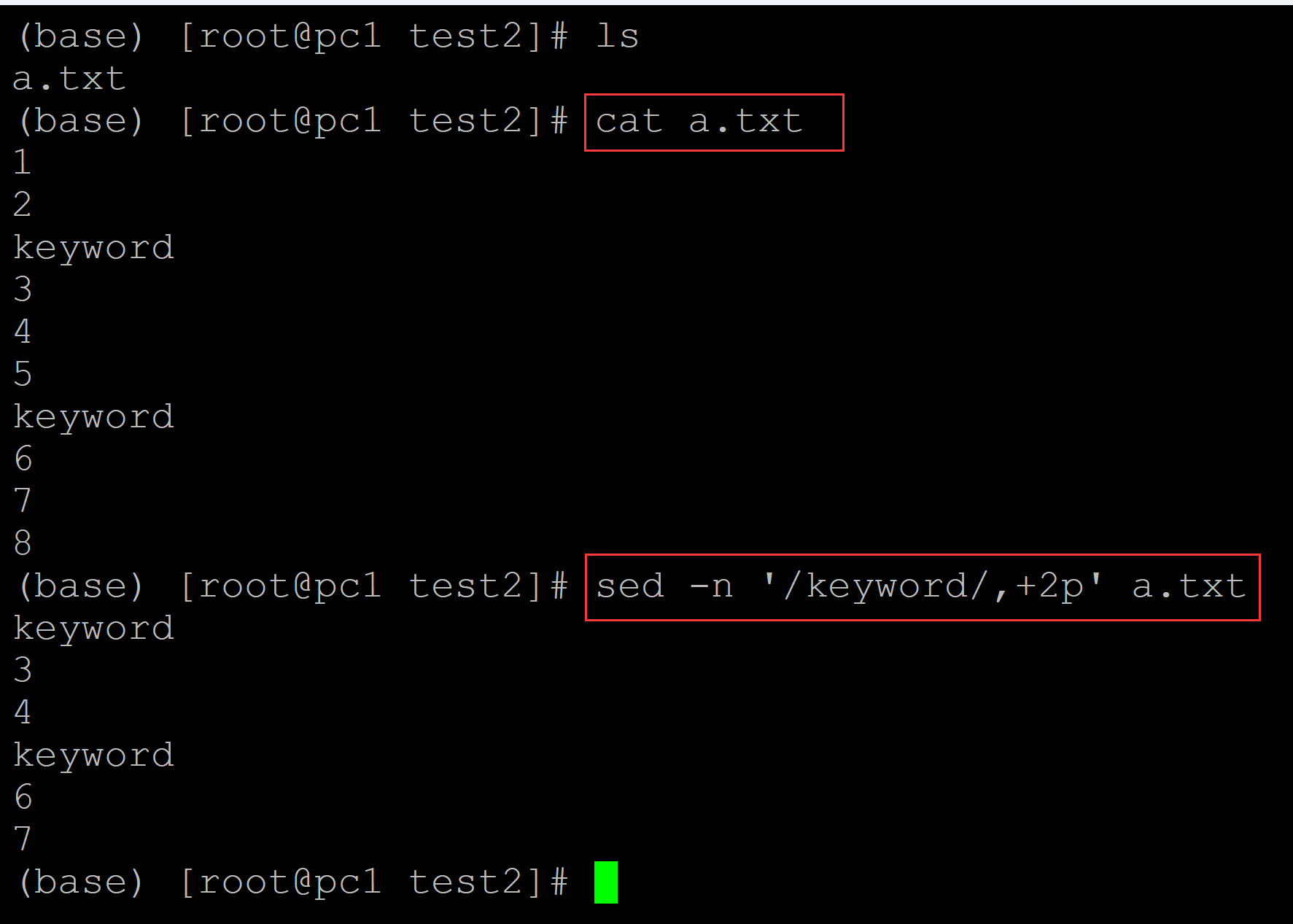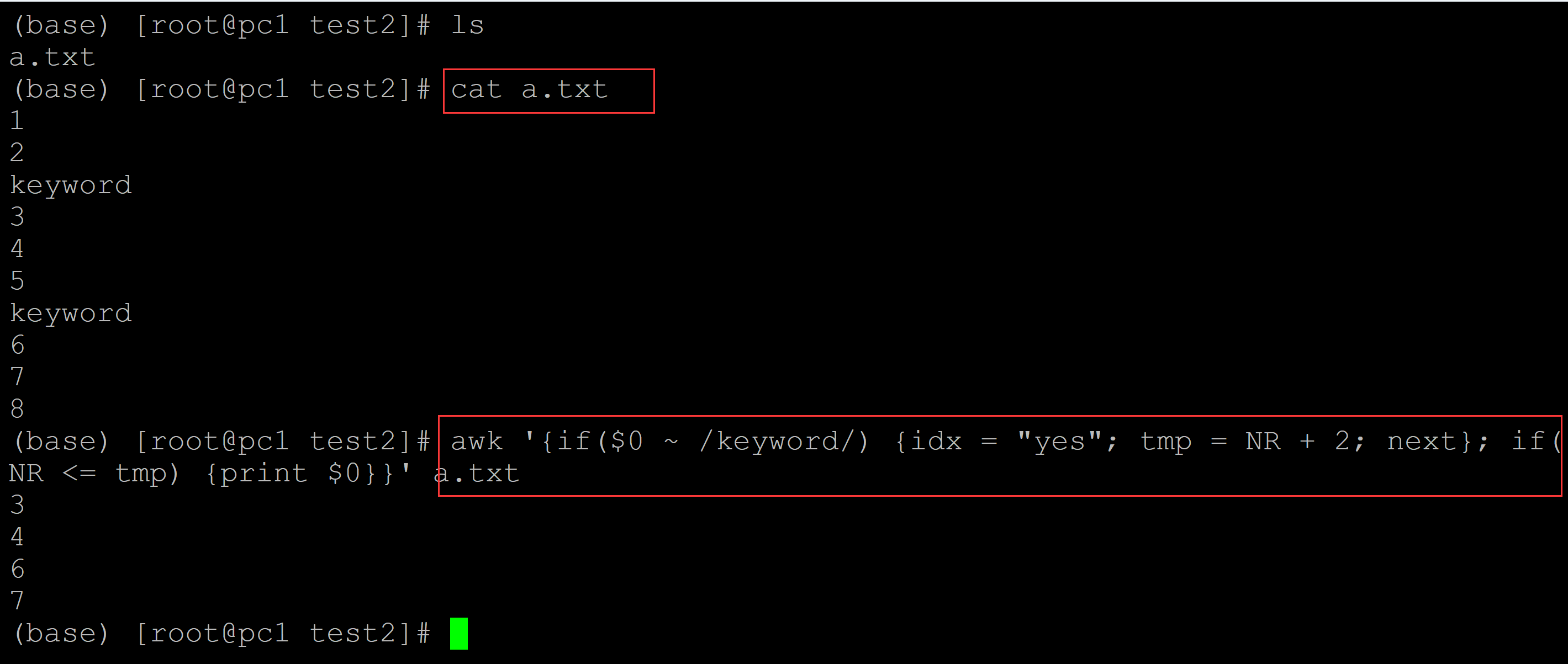linux 中sed命令输出匹配字符的若干行
001、grep实现
(base) [root@pc1 test2]# ls a.txt (base) [root@pc1 test2]# cat a.txt ## 测试数据 1 2 keyword 3 4 5 keyword 6 7 8 (base) [root@pc1 test2]# grep "keyword" -A 2 a.txt ## 输出匹配字符后面的两行 keyword 3 4 -- keyword 6 7

002、sed实现
(base) [root@pc1 test2]# ls a.txt (base) [root@pc1 test2]# cat a.txt ## 测试数据 1 2 keyword 3 4 5 keyword 6 7 8 (base) [root@pc1 test2]# sed -n '/keyword/,+2p' a.txt ## 输出匹配字符后面的两行 keyword 3 4 keyword 6 7

003、awk实现
(base) [root@pc1 test2]# ls a.txt (base) [root@pc1 test2]# cat a.txt ## 测试数据 1 2 keyword 3 4 5 keyword 6 7 8 ## 输出匹配字符及其后的两行 (base) [root@pc1 test2]# awk '{if($0 ~ /keyword/) {idx = "yes"; tmp=NR}; if(NR <= tmp + 2 && idx == "yes") {print $0}}' a.txt keyword 3 4 keyword 6 7

004、不包括匹配的关键字,grep + sed实现
(base) [root@pc1 test2]# ls a.txt (base) [root@pc1 test2]# cat a.txt ## 测试文本 1 2 keyword 3 4 5 keyword 6 7 8 (base) [root@pc1 test2]# grep "keyword" -A 2 a.txt | grep -v "keyword" ## 输出关键字后两行,不包括关键字 3 4 -- 6 7

005、不包括匹配的关键字,sed实现
(base) [root@pc1 test2]# ls a.txt (base) [root@pc1 test2]# cat a.txt ## 测试文本 1 2 keyword 3 4 5 keyword 6 7 8 (base) [root@pc1 test2]# sed -n '/keyword/,+2{/keyword/b;p}' a.txt ## 输出匹配字符后边的两行 3 4 6 7

006、不包括关键字,awk实现
(base) [root@pc1 test2]# ls a.txt (base) [root@pc1 test2]# cat a.txt ## 测试文本 1 2 keyword 3 4 5 keyword 6 7 8 ## awk实现 (base) [root@pc1 test2]# awk '{if($0 ~ /keyword/) {idx = "yes"; tmp = NR + 2; next}; if(NR <= tmp) {print $0}}' a.txt 3 4 6 7

。






【推荐】国内首个AI IDE,深度理解中文开发场景,立即下载体验Trae
【推荐】编程新体验,更懂你的AI,立即体验豆包MarsCode编程助手
【推荐】抖音旗下AI助手豆包,你的智能百科全书,全免费不限次数
【推荐】轻量又高性能的 SSH 工具 IShell:AI 加持,快人一步
· 震惊!C++程序真的从main开始吗?99%的程序员都答错了
· 【硬核科普】Trae如何「偷看」你的代码?零基础破解AI编程运行原理
· 单元测试从入门到精通
· 上周热点回顾(3.3-3.9)
· winform 绘制太阳,地球,月球 运作规律
2022-09-25 pindel软件的基本用法